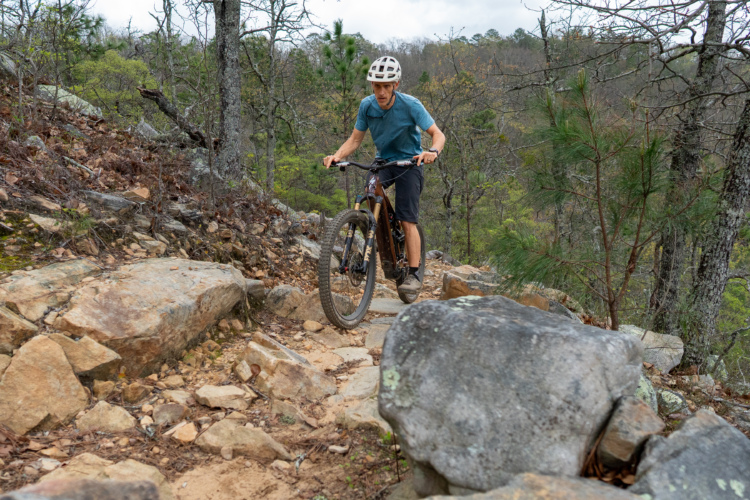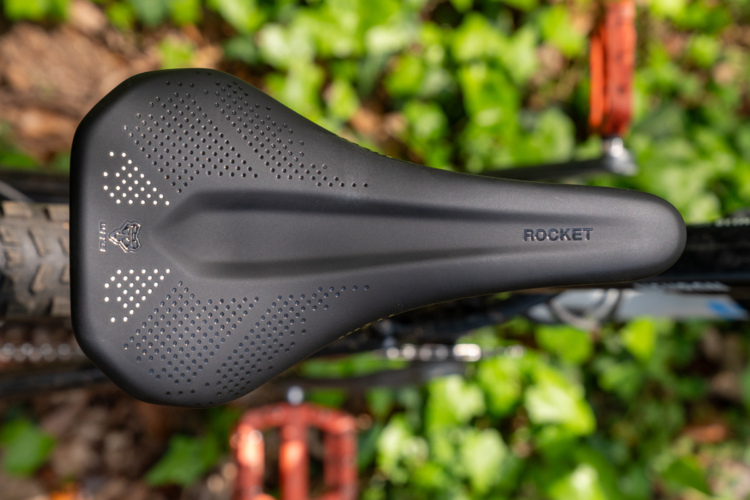
Norco’s latest Optic, released last month, may be one of the most interesting of the year, for one reason: The 125mm bike went from a run-of-the-mill (but exceptional) short-travel, four-bar trail bike to a still exceptional four-bar trail bike, but with a high pivot and idler pulley!
How many other short-travel/high-pivot bikes are out there? Not many. I believe the Optic may have edged out the 130mm Forbidden Druid to take the cake for the shortest.
There’s a lot of room to debate if high pivots are necessary on bikes at this length of travel, and that’s fair, but what I can say is that I had a lot of fun riding the new Norco Optic around Sedona, and the move doesn’t seem to have taken anything away from the bike.
Norco Optic key specs
- Rider Profile: 5’8” and 175lb with gear. Size 3 29er bike tested.
- Suspension travel: 125mm/140mm rear/front
- Frame highlights: C1 29er tested, available in full carbon or full aluminum, with VPSHP (Virtual Pivot Suspension–High Pivot) suspension layout, mixed-wheel build or 29er
- Geometry highlights: 64° HTA, 472.5mm reach, 77° STA, 428mm chainstays, 1,221mm wheelbase
- Price: $9,099 for the C2 build as tested. Alloy frames start at $2,099.
- Buy from: JensonUSA
About the 2024 Norco Optic
The big change to the Optic, as we’ve discussed, is their VPSHP (Virtual Pivot Suspension/High Pivot) platform, which adds the high pivot and idler pulley to a Horst link layout.
The revised platform increases the rearward axle path compared to the previous version, which Norco says improves its performance in technical terrain and minimizes pedal kickback. The suspension has been tuned for efficiency and responsiveness.
The suspension characteristics feel very Norco-like and familiar to most iterations of a Horst link, just with a high pivot placement now. The rear axle and brake are mounted to the seatstays. With the high pivot, the chainstay is raised for better control of the axle path and an increased rearward axle path, keeping the bike more composed through technical trails and the idler pulley keeps chain growth in check as the suspension compresses.
Historically, high pivots and idlers have been reserved for longer-travel bikes, since with more suspension to compress, there is more chain growth that occurs, resulting in more pedal feedback. That isn’t to say that a short-travel bike like the Optic doesn’t benefit from the design, but probably not as much as a bike like the Sight.
Norco Optic geometry
The geometry on the Optic changes, but not severely. The HTA stays the same at 65° and the STA steepens by 1° (tested in a size 3). The wheelbase gets longer by about an inch and the reach has lengthened by nearly an inch too, putting the size 3 at 472.5mm. The chainstays are either 429mm for a 29er or a stubby 423mm if you’ve got the MX version.

Frame details
In order to do the 29″/27.5″ swap, you’ll need to invest in the Missing Link kit from Norco, a $135 kit with an extra rocker link and lower shock mount. It’s more complicated than a flip-chip, which is common on most bikes that are mixed-wheel compatible, however Norco says the kit is the best way possible to keep suspension kinematics and geometry consistent with the wheel swap. The new Sight works the same way.
Other details worth noting are the downtube and shuttle guards under the bike, internal cable routing, and a tool mount and water bottle mount inside the frame. There is no frame storage box or glove compartment. Norco has opted to keep things simple on the Optic.
The Optic is also now either a full carbon frame or a full aluminum. The aluminum frameset is priced at $2,099 while the carbon frameset is is $3,849. Completes start at $3,999 for an aluminum MX version.
Build kit
The price as tested on our C1 carbon fiber build is $9,099 and that includes SRAM X0 Eagle Transmission, SRAM Level Stealth Silver brakes, a Fox Factory 34 fork with Grip 2 damper and Fox Float X Factory shock with We Are One carbon wheels and Industry Nine 1/1 hubs.
Everything worked great for me. There’s no surprises with SRAM Transmission at this point, nor with the Fox Factory level suspension.
One area that could use a boost is the brakes. The Levels are a decent light trail (or cross-country) bike brake, but the Optic proved capable of much more and the brakes were gasping for air holding my weight down the slabs of Hiline in Sedona. A Code brake might be overkill, but a set of Shimano XT 4-pistons or TRP Trail Evos would be perfect.
Bike setup
I set up the Norco Optic with the brand’s Ride Aligned program, entering my height and weight, riding style and position, and the type of terrain I expected to ride. The program gave me back my suspension and tire pressure and put me in the right range of pressures very quickly.
I did back my compression damping off a little on the trail. That can often change based on the type of terrain, but Ride Aligned got me out riding with much less fiddling around than on most bikes.

On the trail with the Norco Optic
I rode the Norco Optic in Sedona for a day with two main trails: a jaunt up and down the infamous and technical Hiline. If you haven’t ridden this one, it’s full of rocky, steep, brake-squeezing lines, with some faster chunk and flow toward the end.
At the end of the first day, we rode Brewer, a short but fast and flowy, chunky descent where I could let of the brakes and let the suspension eat up the red rock and dirt.
Climbing
I’d ridden the 150mm Sight the day before, and I was excited to shed an inch of travel for this climb. In reality, both the 150mm and 125mm bikes have their advantages climbing in Sedona. The Sight is more active for a wider range of its travel and it’s a very predictable climber that lets you pause and reassess without having to dab as the suspension glues you in place.
The Optic is a more spritely climber, but like a lot of shorter travel bikes, you can’t let off the throttle on a techy spot, or you’ll lose your place.
That was fine with me. Overall, it’s more efficient, so you’re not necessarily losing more energy, you just have to manage it differently. The shorter wheelbase and responsiveness of the bike made the punchy, leg-sapping climb up to the top of Hiline enjoyable as it hops up and over ledges and obstacles with ease. This was slightly surprising to me, especially with the longer reach. The geometry felt comfortable almost immediately.
The Optic is indeed a “shorter-travel” full-suspension bike, but it feels like it is skewed outside of the “downcountry” label and is squarely a trail bike, especially with the 140mm fork. The bike isn’t a slug, but it’s not nearly as quick under pressure as other 120-130mm bikes.
Descending
Everything about the Optic’s design suggests the bike will be a blast downhill: the full carbon frame, the high pivot and idler pulley, and stable but lively geometry. Hiline was an interesting test trail for the bike. There are a lot of steep and dicey lines, but it still doesn’t have a lot of high-speed drops or repetitive rock hits and the descents are short, so a shorter-travel bike is a great choice.
The frame is noticeably stiff, so dial in your suspension quickly on trails like Hiline. The Optic danced over ledgy, square-edge and repetitive hits with speed, a benefit of the rearward axle path.
I won’t go all-out and say I’m a believer on equipping all short-travel bikes with a high pivot and idler, but the suspension’s composure landing off of a drop and diving into the next stack of rocks was outstanding. You can feel the shock compress and return to neutral without a bunch of fuss, or even noise, from the chain. I’d say it’s one small improvement in suspension performance as the gains are mostly associated with deeper or faster hits on a ride. I suppose that’s the benefit of incremental improvements and it’s nice that we can benefit from the development at this point in time.
A handful of us that rode both the Optic and Sight agreed that the Optic made a better Sedona bike, with its punchy ups and downs, where every climb and descent is right around the corner. Somewhere like where I’m at in Colorado, the Optic would still do nicely, but you’d enjoy the Sight more on longer, rockier descents. The Optic is also more than capable of most lines in rocky Sedona too.
On our last lap on the Brewer trail we got a nice mix of rain and snow and had some wet trail conditions. I didn’t have a lot of time to investigate, but the drivetrain became more audibly grumpy with a helping of Sedona red dirt and grit. It’s probably nothing a quick rinse wouldn’t fix, but it would follow that with an extra cog in the system, there will be more noise in less-than-ideal conditions.

Pros and cons of the Norco Optic C1
Pros
- Versatile, short-travel trail bike
- Predictable, composed suspension
- Punches above its travel
Cons
- Wheel swap requires additional Missing Link kit
- Not as energetic as some other short-travel bikes
- Could benefit from stronger brakes
Bottom line
If you start breathing heavy just thinking about pedaling around enduro bikes and also like the liveliness and thrash-ability short-travel bikes bring, you’ll have a hard time finding a better bike than the Norco Optic.





















1 Comments
Mar 21, 2024